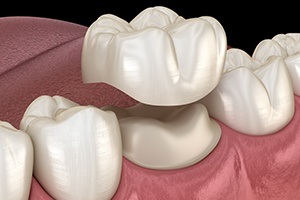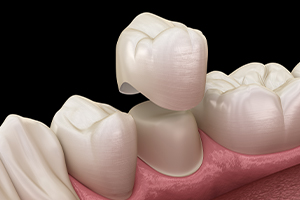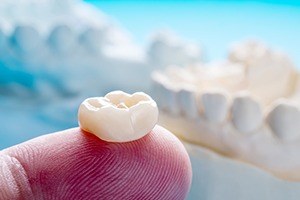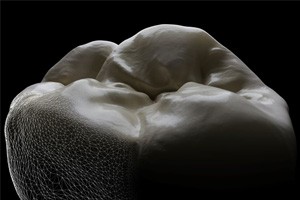
Dental Crowns – Westborough, MA
Renew and Protect Damaged Teeth

Are you considering a dental crown to help get your smile back to its prime? Here at All Dental, we know you have a lot of questions about what a dental crown procedure looks like. Let us take the mystery out of dental crowns! We are a full-service dental office ready to help your smile. If you live near our dental office, you can reach us online or call to schedule a consultation and see if dental crowns from our Westborough, MA dentist are the right choice for you.
Why Choose All Dental for Dental Crowns?
- All-Porcelain Crowns Available
- Gain a Restored Tooth in Just One or Two Appointments
- Highly Functional, Aesthetically Pleasing Results
What Is a Dental Crown?

Crowns can improve dental health in both children and adults. Teeth that have been structurally compromised can benefit from the strengthening power of dental crowns. A dental crown is a piece of porcelain, metal, or ceramic that sits on top of the underlying tooth and covers most or all of the tooth up to the gum line. Crowns can be used to hold weak, cracked teeth together, build up worn-down teeth to their prior glory, and protect cavity-damaged teeth from cracking or falling out after a large filling. Sometimes a crown will be used in conjunction with bridges and root canals to protect the teeth and provide extra support.
Is a Dental Crown Right for Me? What Are My Choices?

If a tooth is extremely cavity-damaged, a crown can be a better choice than a filling alone. In the case of a large filling, the pieces of remaining tooth might be too small to hold together. A crown provides protection to prevent cracking and the development of additional cavities in the tooth, saving you time and money in the dentist’s chair.
Teeth that have been worn down or cracked due to other health issues or tooth grinding can be saved by dental crown procedures. Having crowns done in these circumstances prevent further damage to the teeth and keep teeth from being lost completely if left untreated.
Dental Crowns Save Teeth — But What Are Your Options for Dental Crowns?

Crowns can be made from several different materials, and the one that is right for you will depend on which tooth is being treated and your personal preference. Stainless steel, porcelain, ceramic, and metal alloys are some of the possible choices. Crowns tend to last 5 – 15 years before needing to be replaced.
Stainless steel crowns are usually the best choice for children because they are cost-effective, strong enough to last, and will naturally come out when the child loses the protected tooth. This type of crown is also great for permanent teeth that only need to be covered temporarily.
Metal crowns, including silver, are very strong and good choices for back teeth that will be out of sight and doing a lot of chewing.
Ceramic and porcelain crowns are the best choices if your main concern is color-matching, particularly with teeth that will show while smiling and talking. Porcelain-fused-to-metal can also be color-matched. The extra strength of the metal is great for supporting bridges.
Zirconia crowns are both strong and can be color-matched to your teeth. The big bonus of zirconia crowns is that they can be done in one single appointment, rather than two as with most other crowns.
Resin is another option. This type of crown is weaker than the others, but also cheaper.
How Do Dental Crowns Compare to Actual Teeth?

Permanent crowns can be just as strong as regular teeth. In general, the crown will even be stronger than the damaged tooth it is getting placed over. It is recommended that you avoid chewing very hard food with crowns, but for the majority of circumstances, a dental crown will act just like a normal tooth.
There are other uses for dental crowns, too. You can even use a crown to improve the look of your smile. Dental crowns can be used to cap discolored or misshapen teeth to make them look exactly how you want.
What Should I Expect from the Procedure?

In the majority of cases, your crown procedure will take two visits.
First Visit

At the first appointment, your dentist will start with an examination of the tooth, sometimes including X-Rays, to assess the extent of tooth damage. After the examination is complete, you will be given a local anesthesia to numb the tooth and surrounding gum tissue. This will keep you free from pain during the procedure. Your dentist will begin filing and shaping the tooth to create a shape that is ready to be capped and will best prevent further damage to the tooth. Once the tooth is finished being shaped, your dentist will take digital images or a physical impression to create the permanent crown. A temporary crown will be put on the tooth to protect it while you are waiting for your second appointment.
This first appointment should take between one and two hours. You may experience some sensitivity after the anesthesia wears off, but it should only be minimal.
Since the temporary crown is not cemented onto the tooth, it is important to avoid sticky and hard foods while waiting for the second appointment. Some people also experience temperature sensitivities during this time as well, so be wary of eating very hot or very cold foods.
Second Visit

The second appointment will normally occur two to three weeks after the first. This visit will begin with the removal of the temporary crown. You will be anesthetized again, your permanent crown will be fitted and checked, and then it will be cemented into place. This visit should only take 30 minutes to an hour. Once again, you may experience minimal pain after the anesthesia wears off.
In total, the cost of the crown will depend on the material used, the tooth replaced, and how much your insurance covers.
If you need a dental crown put in and you live in the Westborough area, do not wait to give us a call. All Dental provides expert, compassionate care at our full-service dental office, and we are ready to help.
Dental Crowns FAQs

The All Dental Team in Westborough is ready to repair your damaged teeth with dental crowns. Before you attend your restorative consultation, though, you might want to know more about this treatment and what you can expect from it. To help you gather information, we have put together the following list of dental crowns FAQs. If your questions are not addressed here, make a note and give our office a call. We will be happy to speak with you!
Are Dental Crowns Permanent?
Dental crowns are permanent in a sense. The preparation phase of treatment requires that we remove a bit of enamel from the tooth that will receive the crown. The enamel will never grow back on its own, so the tooth will always need a crown to protect it from outside stimuli.
Although dental crowns require a permanent commitment, the restorations themselves cannot be expected to last forever. On average, a crown endures for 5 – 15 years before replacement becomes necessary. You can help your crown last as long as possible by sticking to a thorough oral hygiene routine, regularly visiting us for checkups, and taking other practical measures.
How Do You Know When a Dental Crown Needs to Be Replaced?
Here are some indications that you should visit your dentist so they can examine your crown:
- You are experiencing pain or sensitivity in the tooth beneath your crown.
- A crown feels loose or unsteady.
- Your crown is making it difficult for you to chew or bite down comfortably.
- Your crown has visible signs of wear. For example, if you have a porcelain-fused-to-metal crown, you might see a dark line at its base.
During your appointment, your dentist will let you know for sure whether your crown needs to be replaced.
Do Dental Crowns Get Cavities?
No, dental crowns cannot get cavities due to the accumulation of plaque and bacteria. However, the teeth underneath crowns are at roughly the same risk of decay as uncrowned teeth. That is because if plaque accumulates along the gumline, it can sneak beneath the crown and begin to eat away at the underlying tooth.
It is possible to greatly reduce your risk of cavities by adhering to a thorough oral hygiene routine. Be especially diligent about cleaning along your gumline.
Does It Hurt to Get a Dental Crown?
Your dentist will numb your tooth when they are preparing it to fit beneath your crown, so you should feel little discomfort. After the local anesthesia wears off and you are wearing a temporary crown, you may notice that your tooth and the surrounding gum tissue are extra sensitive. This can also happen when your permanent crown is placed.
Any discomfort should wear off within a few days or weeks after you get your restoration. If you have any lingering pain or other concerns, give us a call right away.